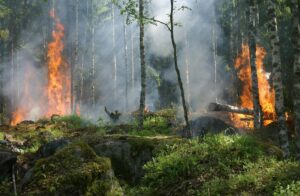 June 5, 2025 A dense blanket of wildfire smoke from more than 200 fires burning across Canada has shrouded nearly one-third of the United States, triggering widespread air quality alerts and renewed concerns about public health. The smoke, drifting from blazes in the Canadian provinces of Manitoba, Saskatchewan, and Alberta, has turned skies hazy and pushed toxic pollution levels to hazardous highs in parts of New England, New York, and the Midwest.
June 5, 2025 A dense blanket of wildfire smoke from more than 200 fires burning across Canada has shrouded nearly one-third of the United States, triggering widespread air quality alerts and renewed concerns about public health. The smoke, drifting from blazes in the Canadian provinces of Manitoba, Saskatchewan, and Alberta, has turned skies hazy and pushed toxic pollution levels to hazardous highs in parts of New England, New York, and the Midwest.
According to the National Weather Service’s Weather Prediction Center, the smoke has spread from the Dakotas through the Ohio Valley and into the Northeastern states, reaching as far south as Georgia. While much of the smoke remains suspended in the upper atmosphere, areas like New York and Connecticut are experiencing a heavier concentration near the surface leading to significantly degraded air quality.
Toxic particles and vulnerable populations
The smoke carries tiny, toxic particles known as PM2.5 fine particulate matter that can infiltrate deep into the lungs and bloodstream. These particles are especially dangerous for vulnerable populations including infants, the elderly, and people with pre-existing health conditions such as asthma or heart disease.
Yang Liu, an environmental health professor at Emory University, underscored the wide-reaching effects. “The impact is universal across demographics,”Expert said. “Even healthy adults are not immune. Prolonged exposure to wildfire smoke can cause respiratory irritation, fatigue, and increase the risk of cardiovascular events.”
The scale of the fires is alarming. As of Tuesday afternoon, the Canadian Interagency Forest Fire Centre reported 212 active wildfires, with more than half considered out of control. Already, the fires have scorched over 2 million hectares nearly 5 million acres of land. Firefighters are battling the blazes under difficult conditions, with dry vegetation and strong winds fueling rapid spread.
A growing climate challenge
This year’s wildfire season began early and aggressively in Canada, raising questions about the escalating role of climate change in driving extreme fire behavior. Warmer temperatures and prolonged droughts have created the ideal conditions for wildfires to ignite and thrive. Experts say such intense smoke events could become more frequent and widespread in the coming years.
“Each summer, we’re seeing more fires, larger burned areas, and more days with dangerous smoke levels,” said Experts . “It’s a disturbing trend that not only affects ecosystems and air quality but also has long-term consequences for public health.”
Precautions and outlook
Health authorities across affected U.S. states have urged residents to limit outdoor activities, especially during times when smoke levels are highest. People with respiratory conditions are advised to stay indoors, use air purifiers, and wear N95 masks if venturing outside is necessary.
Air quality alerts remain in effect across several regions, including New York City, Boston, and parts of the Midwest. Weather forecasts suggest that the smoke may linger over the eastern U.S. for the next few days, depending on wind patterns and ongoing fire activity in Canada.
As firefighting efforts continue north of the border, U.S. officials are closely monitoring the smoke’s trajectory and its health impacts. The episode is a stark reminder that the climate crisis does not respect borders and that its consequences, from wildfires to air pollution, are increasingly shared on a continental scale.
